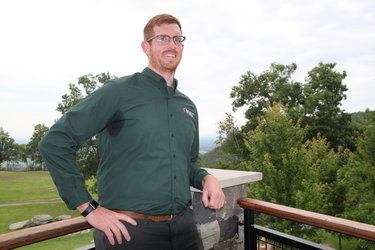New Thacher Park manger likes caring for the land and connecting with people
ALBANY COUNTY — William Hein stands 6 feet, 6 inches tall. At age 32, he has a Paul Bunyan look, with short-cropped reddish hair and beard.
When Hein was a college student, he did a stint at one of the Adirondack Great Camps, on Raquette Lake, learning about the wilderness on hiking and canoe trips.
“For me and my size, I realized how small I am in this world,” he said. “It really touched me.”
In May, Hein became the manager of John Boyd Thacher State Park. He now oversees the more than 2,000 acres of Helderberg parkland and 30 summer employees, 15 in the winter months.
He left his Long Island roots to put down new ones in the Hudson Valley.
Hein grew up in Babylon in Suffolk County with two older sisters and a younger brother, the children of a nurse and machinist. As a teenager, Hein worked summers at Robert Moses State Park with five miles of beach on the Atlantic Ocean.
He liked the outdoor work but went off to college at the State University of New York at Cortland with the idea of becoming a history teacher. Hein then worked summers at the Connetquot River State Park Preserve, once the home of the Southside Sportsmen’s Club, which catered to the Long Island’s wealthy in the late 19th and early 20th centuries.
“The Vanderbilts and Teddy Roosevelt were members. They still have the lockers from back in the day and the taxidermy,”said Hein. He himself is not a hunter.
His main job was landscaping and grounds work. “We’d fill Dumpsters every day,” he said of the trash left by visitors, noting that Thacher has a policy that patrons carry out what they’ve carried in.
Hein liked running tractors and other equipment, like a surf rake that picks up litter, seaweed, and rocks from the beach, giving it a “finished look,” he said.
“I loved how it changed every day; there was always something new,” he said of park work. “You plan for the long-term but you have to be spontaneous in meeting needs when they arise.”
He ultimately decided he didn’t want to spend his life in a classroom, Hein said, and majored in recreation, parks, and leisure studies.
“The recreation field is not just taking care of land; it is connecting to people ...,” said Hein. “I use my history background for the stories we tell with parks.”
He then launched into the story of Albany mayor John Boyd Thacher and his wife, Emma Treadwell Thacher, who donated the original Helderberg parkland in 1914 after her husband’s death.
It was at Cortland’s Outdoor Education Practicum on Raquette Lake where Hein had the wilderness experience that put his size and his future in perspective.
After graduation, Hein did disaster relief work following SuperStorm Sandy and then worked for the Town of Babylon Parks and Recreation. His hometown parks department had 10 facilities and 200 employees. Heins had a supervisory role where he learned to juggle and to make important decisions, he said.
He then went to work for the newest state park, Buffalo Harbor, which had a 1,000-boat marina and a state-of-the-art playground. Hein called it “a beautiful spot on the shores of Lake Erie,” and said, “I took it as a challenge to keep it as new as possible.”
He learned much from an “amazing mentor,” Vinnie Iacovitti, and applied those skills as a supervisor of a park back on Long Island, Nissequogue River State Park — located at the site of a massive, old psychiatric center.
“Exactly a year later, I found myself here,” said Hein.
He had decided Long Island wasn’t for him. “It’s just too developed,” said Hein. “I like the Hudson Valley a lot and it’s a quick drive to the Adirondacks.”
Hein was assistant manager at Thacher for two years before being promoted to manager in May. He plans to stay a long time.
“I think I’ve found my place,” said Hein. “I’ve settled down, which feels good. It’s comforting.”
“Jumping into a frozen lake”
The pandemic was a “huge challenge” for the park and its staff, said Hein.
Staff would drive to a warehouse on North Ferry Street in Albany every day to get supplies — from personal protective equipment to vaccine — and then transport the supplies to regions in need.
“It was all hands on deck,” said Hein. “When Parks is called upon, we answer as best we can,” he said, noting that Parks and Recreation is second only to the Department of Transportation among state agencies in terms of having equipment.
At the same time, during the pandemic, Hein said, there was an “explosion” in attendance at Thacher Park. Attendance nearly doubled over the previous fiscal year, which runs from April through March, to 1.2 million visitors.
Staff repeatedly cleaned bathrooms, sanitized surfaces, and offered hand sanitizer — “anything to keep people safe,” said Hein.
“It was like jumping into a frozen lake,” he said. That is something Hein has done.
“You want a sauna nearby,” he added. “It refreshes you and invigorates you.”
So, too, did the pandemic experience at Thacher Park, he said. “You realize we’re adaptable. You realize the potential of your staff. They did an amazing job.”
Diversity and inclusion
Hein noted that Thacher Park developed a master plan five years ago, leading to the visitors’ center being built in 2017.
He often references the plan. “We still have work to do; it’s ever-changing,” he said.
Hein went on to highlight a number of the initiatives he is most excited about.
He is interested in the history of the old Helderberg Ski Club, which had a ski school with certified instructors and a National Ski Patrol in the mid-20th Century.
Skiers climbed up the hill to ski down. This was exemplified in the club’s triangular patch, which depicted the herringbone pattern used to climb the slope.
The original clubhouse burned, but a lean-to still stands. Hein is working with the Friends of Thacher Park to see about restoring it.
He is also interested in the ski club’s original members; some were World War II veterans who had served in the 10th Mountain Division and one was Alice Waterhouse, the first woman to climb all 46 Adirondack High Peaks.
“The Helderberg Ski Club is one of those pieces of history that show global community, show we are all part of this together,” Hein said.
The park, he said, is focusing on diversity, equity, and inclusion and this would highlight a trailblazing woman like Waterhouse “when in years’ past she broke down barriers in a time when it wasn’t expected.”
Another diversity and inclusion initiative Hein is excited about is the Nature Bus. “It’s the brainchild of Sarah Walsh at the Mohawk Hudson Land Conservancy,” he said.
The Capital District Transportation Authority is running the free bus from five points in Albany to Thacher Park and eight other parks.
The Nature Bus runs every Saturday through Sept. 25, picking up passengers at these intersections in Albany: Livingston and Lark, North Pearl and State, South Pearl and State, Second and South Pearl, and Second/Whitehall and Delaware — with more details on the CDTA website.
“It increases access to green space to people who might not have that opportunity otherwise,” Hein said.
“Sheer variety”
Hein is also excited about disc golf, which he explains is like playing golf with a Frisbee. There’s no charge for players beyond Thatcher’s $6 parking fee. Players tee off by flinging their discs towards poles with baskets set up on a course.
He is also pleased to support a 20-year tradition of an annual Hawk Watch, during which birdwatchers count and document migrating raptors every September. Hein hopes to update interpretive signage for the birders.
“We want to help grow it,” Hein said.
Indian Ladder remains the park’s most popular trail. It opened for the season on June 26 and will stay open through October or until the first frost.
The trail had been closed in July 2017 after falling rocks paralyzed a woman walking along the trail. Now, said Hein, there is a statewide scaling team that comes to Thacher every year. Team members — Hien called them “adrenalin junkies” — scale the cliffs and use pointed poles to dislodge loose rocks to prevent them from falling on hikers.
Hein also spoke of a mountain-bike skill park near Hailes Cave; the cave itself is closed to visitors to protect the bats. The skill park, he said, “has jumps and rocks to climb on and an array of trails, ranging in difficulty.”
Sport climbing is also popular at Thacher. The park has partnered with the Thacher Climbing Coalition, Hein said, which has developed routes for people to rock climb. Climbers bring their own gear and sign an acknowledgement of risk, he said.
“We get people from all over the nation — even a few from Brazil,” he said, judging by license plates on parked vehicles.
Sport climbing, Hein explained, is different from traditional, or trad, climbing because, in sport climbing, anchors are set in the rock and climbers clip into pre-placed bolts.
“We don’t allow trad climbing here; it’s more dangerous,” said Hein.
He concluded, “The best part about Thacher is the sheer variety.”
Hein named activities including swimming in Thompsons Lake, hiking, sport climbing, mountain biking, snowshoeing, and both cross-country and downhill skiing — “if you’re willing to climb up.”
He went on, “There’s something for everyone …. People have weddings here; they have graduation and birthday parties.
“We try to work on our viewsheds, to keep the vistas clear … so people can feel that smallness that I felt.”
Finally, Hein said, “The recreational opportunities are typically passive — you can do it on your own.”
He struggled for the right words. “I don’t want to call Thacher a jack-of-all-trades. It’s more like: What’s your fancy?”



